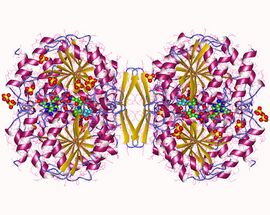Biology:Homoisocitrate dehydrogenase
| homoisocitrate dehydrogenase | |||||||||
|---|---|---|---|---|---|---|---|---|---|
 Homoisocitrate dehydrogenase tetramer, Thermus thermophilus | |||||||||
| Identifiers | |||||||||
| EC number | 1.1.1.87 | ||||||||
| CAS number | 37250-23-0 | ||||||||
| Databases | |||||||||
| IntEnz | IntEnz view | ||||||||
| BRENDA | BRENDA entry | ||||||||
| ExPASy | NiceZyme view | ||||||||
| KEGG | KEGG entry | ||||||||
| MetaCyc | metabolic pathway | ||||||||
| PRIAM | profile | ||||||||
| PDB structures | RCSB PDB PDBe PDBsum | ||||||||
| Gene Ontology | AmiGO / QuickGO | ||||||||
| |||||||||
In enzymology, a homoisocitrate dehydrogenase (EC 1.1.1.87) is an enzyme that catalyzes the chemical reaction
- (1R,2S)-1-hydroxybutane-1,2,4-tricarboxylate + NAD+ [math]\displaystyle{ \rightleftharpoons }[/math] 2-oxoadipate + CO2 + NADH + H+
Thus, the two substrates of this enzyme are (1R,2S)-1-hydroxybutane-1,2,4-tricarboxylate and NAD+, whereas its 4 products are 2-oxoadipate, CO2, NADH, and H+.
This enzyme belongs to the family of oxidoreductases, specifically those acting on the CH-OH group of donor with NAD+ or NADP+ as acceptor. The systematic name of this enzyme class is (1R,2S)-1-hydroxybutane-1,2,4-tricarboxylate:NAD+ oxidoreductase (decarboxylating). Other names in common use include 2-hydroxy-3-carboxyadipate dehydrogenase, 3-carboxy-2-hydroxyadipate dehydrogenase, homoisocitric dehydrogenase, (−)-1-hydroxy-1,2,4-butanetricarboxylate:NAD+ oxidoreductase, (decarboxylating), 3-carboxy-2-hydroxyadipate:NAD+ oxidoreductase (decarboxylating), and HICDH. This enzyme participates in lysine biosynthesis.
Structural studies
As of late 2007, only one structure has been solved for this class of enzymes, with the PDB accession code 1X0L.
References
- "Enzymatic formation of alpha-ketoadipic acid from homoisocitric acid". J. Biol. Chem. 240 (11): 4357–61. 1965. PMID 4284830.
- "Homoisocitric dehydrogenase from yeast". Arch. Biochem. Biophys. 141 (2): 499–510. 1970. doi:10.1016/0003-9861(70)90167-0. PMID 4395693.
- "Lysine biosynthesis and metabolism in fungi". Nat. Prod. Rep. 17 (1): 85–97. 2000. doi:10.1039/a801345d. PMID 10714900.
 |

